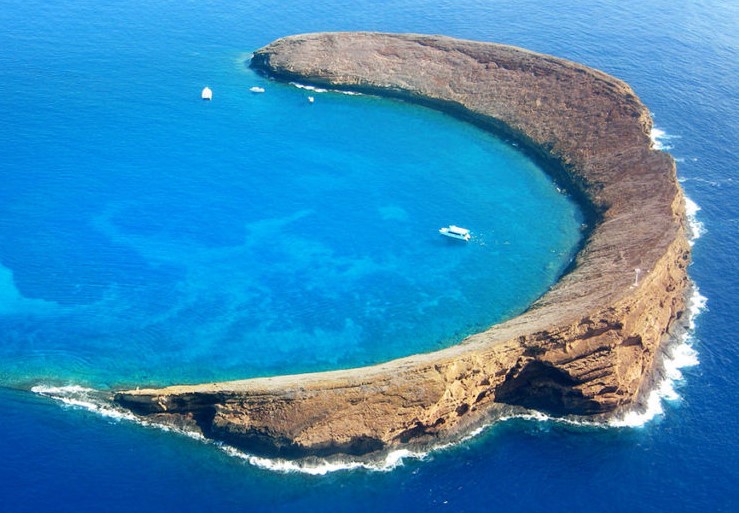Rising like a crescent moon from the crystal-clear waters between Maui and Kahoʻolawe in Hawaii, Molokini Crater isn’t just a snorkeler’s paradise or a diver’s dream—it’s a geologic marvel with a wild history and a vibrant underwater metropolis. Formed over 230,000 years ago by a violent volcanic eruption, this partially submerged volcanic caldera has since evolved into one of Hawaii’s most iconic marine sanctuaries. And while it may only look like a rocky arc from above, beneath the waves lies a world so alive, so colorful, and so clear, it feels like diving into an aquarium designed by nature herself.
With underwater visibility often reaching up to 45 meters, Molokini is a magnet for marine life and underwater photographers alike. More than 250 species of fish call this volcanic reef home—many of which are endemic to Hawaii, meaning you won’t find them anywhere else on Earth (for example Hawaiian domino damselfish, Bandit Angelfish, Thompson’s Butterflyfish).
But Molokini isn’t just about fish and coral. During World War II, this peaceful crescent was used by the U.S. military for bombing practice—a far cry from its current status as a Marine Life Conservation District, designated in 1977 to preserve its vibrant reef ecosystems and unique marine species. Fishing, collecting, and anchoring are strictly prohibited, and only permitted tour operators can bring visitors, helping to minimize human impact. Feeding fish, touching coral, or disturbing marine life is also banned, ensuring that the reef stays healthy and thriving. These protections have turned Molokini into one of Hawaii’s most pristine dive sites.
Molokini’s Dive Menu: Something for Everyone
Molokini Crater may be small above water, but beneath the surface it offers at least 8 main dive sites, each with its own vibe, depth, and challenge level. Whether you’re getting your fins wet for the first time or looking to test your limits along a vertical drop-off, there’s a site for you.
Appetizers for the beginners
Sheltered inside the crescent, these calm, current-free dive sites are ideal for beginners. With crystal-clear water, vibrant coral heads, and schools of colorful reef fish, it truly feels like diving inside a natural aquarium. It’s the go-to site for Open Water courses and first-timers alike.
TAKO FLATS – a sand channel featuring rock formations, crevasses and young coral is world famous for its abundance of octopuses, which are called “tako” in Japanese (hence the name). If you’re lucky enough, you can even spot manta rays here.
MIDDLE REEF – one of Molokini’s most well-preserved treasures, comprising the center of the crater’s massive underwater bowl. The reef here is made up of hard corals and occasionally has giant trevallies cruising through.
Main Course for Intermediate Divers
REEF’S END – an extension of the volcanic rim of Molokini Crater, running underwater for about 100 meters barely breaking the surface. The end and outside of this shoal drop off in dramatic terraces to beyond diving range. The reef is covered with cauliflower coral and in bright sunlight is one of the most dramatic underwater scenes in Hawaii. Almost every kind of fish found in Hawaii can be seen living here or passing through these crystalline waters.
SHARK CONDOS – located at the depth of about 40 meters, you’ll find a collection of underwater caves (referred to as condos) where groups of white-tipped reef sharks like to hang out. Due to exceptional visibility, you can see reef shelves cascading all the way toward the ocean floor.
FLYING SEA CLIFFS – located along Molokini’s exposed back wall, it is a popular dive site known for its distinctive, sheer cliffs that descend to the ocean floor. The cliffs drop down to 80 meters with shelves and nooks filled with coral, sponges, and marine life. Due to possible strong currents, good buoyancy control is a must have skill to be able to fully enjoy the dive.
Exquisite Entrées for Advanced Divers*
THE BACK WALL – is the top rated dive site of the Molokini crater. Dropping straight into the blue, all the way down to 100 meters, the back side of Molokini is reserved for experienced divers only. Known for its dramatic drop-offs, strong currents (strong enough to be referred to as “Next Stop Tahiti”), and encounters with pelagics like manta rays and reef sharks, this wall dive is both thrilling and humbling. The visibility here is often nothing short of world-class.
Here’s a fantastic review of the dive site by experienced diver: “When our divemaster signaled the end of the dive, I realized that we were weightlessly hovering next to a 100 meter vertical wall that went as far as I could see in both directions, and just plunged into the inky depths below. Watching the dive master slowly move away from this monolithic wall out into the vastness of the ocean, I was suddenly struck with the need to cling to the rock, feeling absolutely microscopic and insignificant. I felt like if I moved away from the face that I would fall off the earth forever. She hovered there, motionless, a tiny speck with little shimmering clusters of bubbles lazily drifting up toward the dancing light far above, against the backdrop of deep blue nothingness. Nothing below her, and nothing above her – vulnerable in every direction. As I slowly started kicking away from the wall and looked up, down, and out into the ocean, I felt the same”
EDGE OF THE WORLD – one of the most dramatic areas along Molokini’s back side. Almost-constant darkness and deepest drop-off of Molokini crater. The area experiences shadows, attracting unusual marine life and larger animals like sharks and rays. Strong dive lights is a must to fully indulge this extraordinary dive site. The same current conditions apply, so no doubt this site is for experienced divers only.
* Most dive operators will require Advanced certification, minimum number of dives (30-40) and a last dive no less than within the last 6 months. These rules are there for your own safety and enjoyment of the dives. The dive centers will gladly offer a refresher dive if needed or take you into easier dives to prepare you for the unforgettable experience at the back side of the crater.
When Is The Best Time To Go?
Diving is going on hot and heavy all year-round, but conditions vary seasonally. The best time to dive depends on what you’re looking for: winter (Nov-Mar) is ideal for whale watching, spring (Apr-May) offers the best visibility, summer (June-Aug) provides warm water, and fall (Sept-Oct) is less crowded.
The water temperature ranges from 23°C to 26°C
Molokini’s Secret Guests: Whale Sightings and When to Spot Them
Winter months bring an awe-inspiring surprise: humpback whales. These majestic giants migrate to the warm Hawaiian waters between December and April, and though they don’t swim directly through the crater, they are often seen and heard in the surrounding area.
Whale watching tours commonly depart from nearby Maʻalaea or Lahaina, offering respectful and informative encounters. When choosing a tour, it’s best to go with ethical operators—those that follow NOAA’s whale protection guidelines, avoid chasing or crowding whales, and prioritizing education and conservation. Look for companies certified by programs like the Hawai‘i Ecotourism Association or those that clearly state their commitment to marine wildlife safety.
For divers at Molokini, whale season adds a surreal layer to the experience. You may not see a whale underwater at the crater, but you’ll often hear them singing, especially during quieter moments on your dive. Their deep, melodic vocalizations can travel for miles and are sometimes so resonant that you feel the vibrations in your chest. It’s one of those rare, almost spiritual experiences that divers remember for life.
Choosing a Dive Operator: Recommended Centers for Molokini Adventures
Whether you’re planning your first crater dive or returning for more, choosing the right dive shop can make all the difference. Here are three reputable Maui-based dive operators with Molokini trips that consistently receive great reviews from divers of all levels.
Prodiver Maui – Well-organized, professional team focused on safety and fun. They often pair Molokini with other exciting south shore sites and apart from a standard 2 tank trip they also have Experienced Diver 3-Tank Trip: A longer, deeper dive day tailored to seasoned divers with good air consumption. Includes sites like the Backwall or The Edge Of The World. Highly recommended if conditions align.
Maui Dive Shop – Larger-scale operation with daily Molokini charters. Maui Dive Shop is highlighted for its long-standing reputation and commitment to safety and responsible diving. Good for convenience, gear rental options, and consistent scheduling.
Maui Dreams Dive Co. – Great for smaller groups, relaxed atmosphere, flexible scheduling. Also offering shore dives and private charters.
After the Dive: Exploring More of Maui’s Magic
Most 2-tank Molokini dive trips begin early in the morning (typically 6:00–7:00 a.m.) and wrap up by late morning or early afternoon—leaving you with a whole day to explore!
Whether you’re after lush scenery, culture, or a laid-back afternoon, here are some post-dive ideas nearby:
Relax in Kihei or Wailea – Grab lunch, stroll the beach, or enjoy a sunset mai tai at a local beach bar.
Drive the scenic Upcountry route – Visit Makawao, a paniolo (cowboy) town, or tour MauiWine in Ulupalakua.
Chase waterfalls – Stop by Twin Falls or explore further along the Road to Hana if you’re up for a longer adventure.
Birdwatching at Kealia Pond National Wildlife Refuge – Located nearby in Kihei, it’s a peaceful place for spotting native Hawaiian birds.
Whether you’re diving with majestic manta rays, listening to the haunting songs of whales echoing through the deep, or simply soaking in the beauty of Maui’s coastline, we hope your underwater adventures leave you inspired and recharged. As they say in Hawaiian — “E hauʻoli i kou huakaʻi!” — may your journey be filled with joy, discovery, and aloha!

